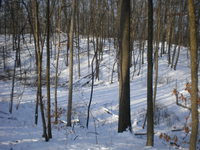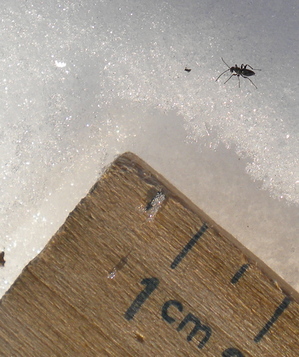Snow insect, mouse and woodpecker sighted at Ann Arbor's Black Pond

Black Pond - January 14, 2010
Stefan Szumko | Contributor
It’s been an exciting week at Black Pond, just north of the Leslie Science and Nature Center. The week started out cold in the teens and warmed up to above freezing by then end.
On my first visit on Sunday, January 10, the snow crunched under foot. At what temperature does snow become crunchy? Apparently, this number is difficult to measure precisely. But the rule of thumb is that the louder the crunch, the lower the snow temperature. The National Snow and Ice Data Center has some great information about winter precipitation.
Weather observations for the week, recorded at Rudolf Steiner High School, 300 meters from Black Pond.
As I walked along the path to the pond, I considered the old saying that the Eskimo-Aleut family of languages has a great number of words for snow. Thank goodness I looked this one up, because this “factoid” is an urban legend.
According to the linguist, Geoffrey Pullum, in his essay about the Great Eskimo Vocabulary Hoax, the simple answer is that there are 2 words for snow used by Eskimo-language speakers: “qanik” - describing snow in the air, and “aput” - describing snow on the ground. The confusion causing this urban legend resulted from the fact there are several languages or dialects used by those described as Eskimos, and that in each of these languages compound words are created using various modifiers to a root word.
Thinking on this topic, how many words and phrases describing snow or frozen precipitation do we use in English? Snow, snowflake, snow drift, blowing and drifting snow, snow pile, snow pack, snow storm, #$@%ing snow, blizzard, white out, sleet, ice, frost, rime, hail, powdery snow, snow patch, avalanche,…I could go on, but looked up this list of 120 English words for snow/ice instead.
Anyway…back to the pond
The mouse living at the pond has been expanding its range, traveling across the pond and up the hill, most likely in search of food. What species of mouse is it? It is either a white-footed mouse, the most common mouse in the deciduous woods of the eastern U.S. and is usually a solitary creature. Or it is deer mouse, which is also common in the eastern U.S. and is solitary during the winter months, but may nest with a few others in this season.
We’ll keep on looking for signs of this critter over the next few weeks. Feel free to suggest names for this furry creature either by leaving a comment below this article or by e-mailing me at slugwhisperer@gmail.com by Saturday, January 23 at midnight. Should we get a few suggestions, we’ll set up a poll next week to see which name wins.
At least one woodpecker was heard tapping on a tree. My young assistant’s attention span did not permit time for a visual observation. We’ll keep our eyes and ears open during upcoming visits.

An insect on top of the snow at Black Pond on January 14, 2010.
Stefan Szumko | Contributor
The warm, winter temperatures (above freezing) at the end of this week have brought out various winter insects throughout Ann Arbor. But only one was observed at Black Pond during my visits. On Thursday, as soon as we stopped to film the overview scene above the pond, Jameson, age 3, stated that he “saw an ant.” Sure enough, there was a small ant-like insect on top of the snow. Unless I hear otherwise, we’re gonna call this a gall wasp, of the insect family, Cynipidae. Classified in the order, Hymenoptera, gall wasps are related to ants. These insects hatch from underground galls on oak roots, gall wasps are wingless and reproduce without males.
We’ll keep on looking for critters and the seasonal changes at the Black Pond this week. Will the mouse be back? Will all the snow and ice melt? Will there be more winter insects appearing?
Stefan Szumko is a middle school science teacher by trade, an outdoor environmental educator by calling, and a homedaddy by choice. He can be reached at slugwhisperer@gmail.com.

Comments
dading dont delete me bro
Wed, Jan 20, 2010 : 5 p.m.
@tdw, early morning (predawn to sun up) when bow hunting (october) near river st. and clark rd. i sit in a tree and have seen shadow's and just a 'whoosh' go by. then not too far, in the direction the shadow went, a "whoo-whoowhoo-whoot"...makes the hair on your neck stand up. it's pretty cool.
tdw
Tue, Jan 19, 2010 : 1:18 p.m.
@Daddling what area and what time do you see owls? I have'nt see one in years.(I think you may have forgoten coyotes too )
Stefan Szumko
Tue, Jan 19, 2010 : 11:21 a.m.
Dulcinea - I intended to refer to the Eskimo-Aleut family of languages which does include various dialects spoken the Inuit, the Yupik, and the Sireniki Eskimos. In the transition from the working document to the version you commented on, the word, "Inuit" was lost.
Dulcinea
Tue, Jan 19, 2010 : 10:57 a.m.
Very interesting article, I enjoyed reading it. However, I believe it is inappropriate to refer to the Northern peoples as 'Eskimo'. The Inuit in Northern Canada and Greenland consider the term pejorative and perhaps others do as well. It would be better to use the specific groups' names (e.g., Inuit, Inupiat, Aleut, etc.) I hope I am not in the minority, but I am always surprised and a little shocked when I see the word "Eskimo" used to refer to these groups of people.
dading dont delete me bro
Tue, Jan 19, 2010 : 10:37 a.m.
do any of you spend time in the woods? i'm a deer and turkey hunter, i spend many hours quiet in the woods. it's amazing the amount of wildlife there is even in close proximity to the city. i see deer, turkey, woodpeckers, owls, you can pretty much name it. it's pretty awesome.
Stefan Szumko
Tue, Jan 19, 2010 : 9:27 a.m.
Til - Thanks for the info about snowfleas. We did see them this week - pretty much everywhere, but not last. I'm just calling them as I see them. I can't wait to get back out and make more discoveries.
Tii
Tue, Jan 19, 2010 : 7:26 a.m.
Don't forget this one. Almost always around if you look closely enough. Snow flea From Wikipedia Snow flea Scientific classification Kingdom: Animalia Phylum: Arthropoda Class: Entognatha Order: Collembola Family: Hypogastruridae Genus: Hypogastrura Species: H. nivicola Binomial name Hypogastrura nivicola (Fitch, 1846) Wingless scorpionflies in the family Boreidae are also sometimes known as snow fleas. Snow fleas (Hypogastrura harveyi and Hypogastrura nivicola) are species of springtail. They are so called because they can most easily be observed jumping about on the surface of snow on a warm winter day. Adults are 12 mm long and their dark blue color makes them appear as specks that have been compared to pepper or ashes scattered on the snow, often near trees. There are many other species of Hypogastrura, most of which can sometimes swarm, but not normally on snow. Like other springtails, they lack wings but can catapult themselves in a random direction by releasing two tail-like "spring" projections (furcula) on abdomen IV. Snow fleas are decomposers and eat decaying organic matter as well as bacteria, fungi, algae, pollen, roundworms and rotifers. It has been assumed that they swarm on snow to feed on algae growing in the snow surface, though it is not clear that this is the case. After mating in the spring, females lay eggs in the soil. The emerging nymphs undergo several moltings; by winter they show all adult features. Research at Queen's University Canada have sequenced and synthesised the anti-freeze-like protein that allows snow fleas to operate in sub-zero environments [1], and found its sequence to be glycine-rich, and unlike any previously known protein. There are hopes that similar proteins may be useful for storing transplant organs and for producing better ice cream.[2] By preventing the formation of ice crystals in tissues, organs could be stored at lower temperatures, increasing their lifespan outside a living body. Unlike proteins with similar functions in other species, the protein found in snow fleas breaks down easily at higher temperatures.[3] [edit] References 1. ^ Lin FH et al, "Structural modelling of snow flea antifreeze protein", 2007, Biophysical journal 92, 1717-1723 2. ^ Tom Simonite. Edible antifreeze promises perfect ice cream, New Scientist, 11 January 2008 3. ^ "New antifreeze protein may allow longer storage of transplant organs". Queen's University. 2005-10-21. http://qnc.queensu.ca/story_loader.php?id=435803469f4c0. [edit]
Stefan Szumko
Mon, Jan 18, 2010 : 9:04 p.m.
bohemianrobot - I, too, saw a fly last week. It landed on the snow at Eberwhite school on Friday. I did get a picture of it. Perhaps I'll have to post an article about winter bug hunting with kids (or without) here on AnnArbor.com in the next week or two? Thanks for the idea. Epengar - You are correct, the insect may have been a snow scorpionfly. Next time I go back to the pond, I'll look to see how far away any mosses are liverworts are from the spot the insect was seen, since these are the food of the snow scorpionfly. I do know that there are plenty of galls growing the oak leaves in the Black Pond Woods. Hence the reason my guess is that of a gall wasp. But I have been known to err in identification. So I thank you for your suggestion and comment.
Epengar
Mon, Jan 18, 2010 : 6:36 p.m.
The insect you saw on the snow might have been a snow scorpionfly. http://bugguide.net/node/view/12104
Angry Sasquatch
Mon, Jan 18, 2010 : 6:28 p.m.
I spotted a flying insect in the snow last week at Matthaei Botanical Gardens. It flew away before I could snap a pic. I had no idea insects adapt to the cold this time of year. I've enjoyed two pondcasts thus far and look forward to the third edition. I also have never been to the Black Pond and plan on exploring soon. Thanks!